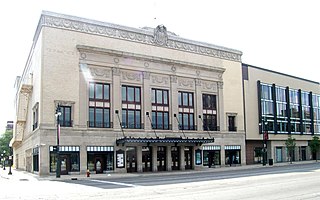
The Detroit Symphony Orchestra (DSO) is an American orchestra based in Detroit, Michigan. Its primary performance venue is Orchestra Hall at the Max M. Fisher Music Center in Detroit's Midtown neighborhood. Jader Bignamini is the current music director of the Detroit Symphony Orchestra, with Jeff Tyzik as Principal Pops Conductor, Enrico Lopez-Yañez as Principal Pops Conductor Designate, and Na'Zir McFadden as assistant conductor. Leonard Slatkin, the previous music director, is the orchestra's current music director laureate. Neeme Järvi, music director from 1990 to 2005, is the orchestra's current music director emeritus.

The Wiener Musikverein, commonly shortened to Musikverein, is a concert hall in Vienna, Austria, which is located in the Innere Stadt district. The building opened in 1870 and is the home of the Vienna Philharmonic orchestra.

Leonard Edward Slatkin is an American conductor, author and composer.

Orchestra Hall is an elaborate concert hall in the United States, located at 3711 Woodward Avenue in Midtown Detroit, Michigan. The hall is renowned for its superior acoustic properties and serves as the home of the internationally known Detroit Symphony Orchestra (DSO), the fourth oldest orchestra in the United States. With the creation of an adjoining auditorium for jazz and chamber music in 2003, Orchestra Hall became part of the Max M. and Marjorie S. Fisher Music Center. It was listed on the National Register of Historic Places in 1971.
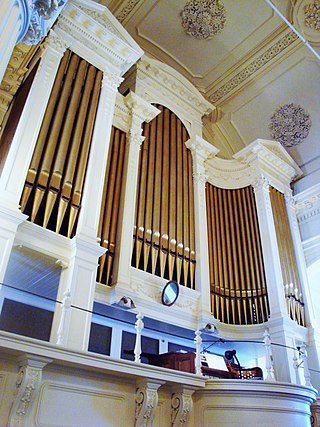
Æolian-Skinner Organ Company, Inc. of Boston, Massachusetts was an American builder of a large number of pipe organs from its inception as the Skinner Organ Company in 1901 until its closure in 1972. Key figures were Ernest M. Skinner (1866–1960), Arthur Hudson Marks (1875–1939), Joseph Silver Whiteford (1921-1978), and G. Donald Harrison (1889–1956). The company was formed from the merger of the Skinner Organ Company and the pipe organ division of the Æolian Company in 1932.

Wirt Clinton Rowland was an American architect best known for his work in Detroit, Michigan.

David Geffen Hall is a concert hall in New York City's Lincoln Center for the Performing Arts complex on Manhattan's Upper West Side. The 2,200-seat auditorium opened in 1962, and is the home of the New York Philharmonic.

The Auditorium is a house of worship and office building located on the greater Temple Lot in Independence, Missouri. The Auditorium is part of the headquarters complex of Community of Christ which also includes the Independence Temple.

The Fox Theatre is a performing arts center located at 2211 Woodward Avenue in Downtown Detroit, Michigan, near the Grand Circus Park Historic District. Opened in 1928 as a flagship movie palace in the Fox Theatres chain, it was at over 5,000 seats the largest theater in the city. Designed by theater architect C. Howard Crane, it was listed on the National Register of Historic Places in 1985.

Hill Auditorium is the largest performance venue on the University of Michigan campus, in Ann Arbor, Michigan. The auditorium was named in honor of Arthur Hill (1847-1909), who served as a regent of the university from 1901 to 1909. He bequeathed $200,000 to the university for the construction of a venue for lectures, musical performances, and other large productions. Opened in 1913, the auditorium was designed by Albert Kahn and Associates. It was renovated by the same firm beginning in 2002 and was re-opened in 2004.
George Donald Harrison was responsible for the design of some of the finest and largest pipe organs in the United States. Born in Huddersfield, England, he first worked as a patent attorney in 1914 but after military service he began to pursue an interest in pipe organ building, working with Henry Willis & Sons of London.
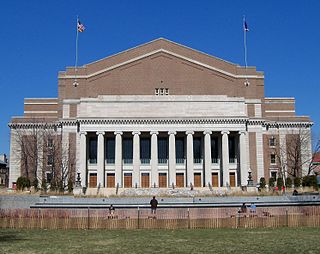
Cyrus Northrop Memorial Auditorium is a performing arts venue at the University of Minnesota in Minneapolis, Minnesota. It is named in honor of Cyrus Northrop, the university's second president. Various events are held within the building, including concerts, ballet performances, lectures, and graduations.

The Christchurch Town Hall, since 2007 formally known as the Christchurch Town Hall of the Performing Arts, opened in 1972, is Christchurch, New Zealand's premier performing arts centre. It is located in the central city on the banks of the Avon River overlooking Victoria Square, opposite the former location of the demolished Christchurch Convention Centre. Due to significant damage sustained during the February 2011 Christchurch earthquake, it was closed until 2019. Council staff initially recommended demolition of all but the main auditorium, but at a meeting in November 2012, councillors voted to rebuild the entire hall. In 2020, the town hall was registered as a Category I heritage building.
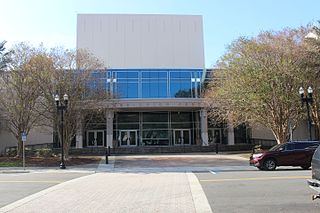
The Jacksonville Center for the Performing Arts (JCPA) is a performing arts center located in Jacksonville, Florida. Situated along the Riverbank, the venue is known as the First Coast’s "premiere riverfront entertainment facility". Originally opening in 1962, the facility was renovated beginning in 1995 until 1997; with a grand re-opening on February 8, 1997. The center consists of three venues: a theatre; concert hall and recital hall. It is home to the Jacksonville Symphony, Jacksonville Symphony Youth Orchestra, and the FSCJ Artist Series.
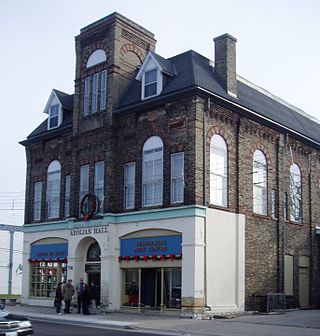
Aeolian Hall is a historic music venue in London, Ontario. The hall is located in a heritage building at 795 Dundas Street, at the corner of Dundas St. and Rectory St, just to the east of Adelaide St.

The Temple Theatre is a historic theater, located on the banks of the Saginaw River in Saginaw, Michigan. The Temple was built in 1927 for the Elf Khurafeh Shriners, and operated for 50 years by W. S. Butterfield Theatres. The theatre complex also contains the former clubhouse of the Elf Khurafeh Shrine, now in use as event space.

The Music Hall Center for the Performing Arts is a 1,731-seat theatre located in the city's theatre district at 350 Madison Street in Downtown Detroit, Michigan. It was built in 1928 as the Wilson Theatre, designated a Michigan State Historic Site in 1976, and was listed on the National Register of Historic Places in 1977.

The Metropolitan United Methodist Church is a church located at 8000 Woodward Avenue in the New Center area of Detroit, Michigan. It was completed in 1926, listed on the National Register of Historic Places in 1982, and designated a Michigan State Historic Site in 1986. This church should not be confused with Metropolitan United Methodist Church in Washington, DC, which is often regarded as a National Church within the United States as it was specifically established by the General Conference to be a "representative presence of Methodism in the nation's capital".

Pease Auditorium is a concert hall on the campus of Eastern Michigan University in Ypsilanti, Michigan. The auditorium was dedicated in 1915 in memory of music professor Frederic H. Pease, at the institution then known as the Michigan State Normal College, and is the fourth-oldest building on the EMU campus. Pease Auditorium is in the Neoclassical Revival architectural style, and was designed by the Detroit-based firm Smith, Hinchman, and Grylls. The auditorium's 1500-seat capacity and excellent acoustics contribute to its reputation as a premier music venue, presenting the performances of the Eastern Michigan University Department of Music and Dance.
The performing arts in Detroit include orchestra, live music, and theater, with more than a dozen performing arts venues. The stages and old time film palaces are generally located along Woodward Avenue, the city's central thoroughfare, in the Downtown, Midtown, and New Center areas. Some additional venues are located in neighborhood areas of the city. Many of the city's significant historic theaters have been revitalized.



















